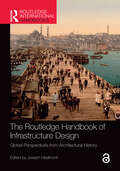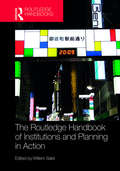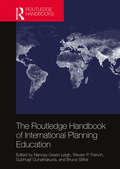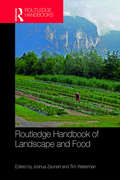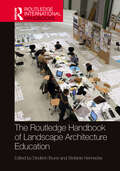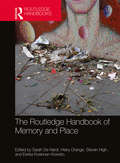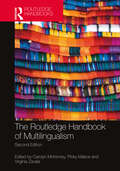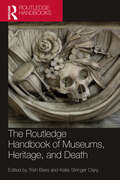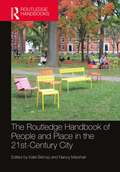- Table View
- List View
The Routledge Handbook of Infrastructure Design: Global Perspectives from Architectural History
by Joseph HeathcottThe Routledge Handbook of Infrastructure Design explores the multifaceted nature of infrastructure through the global lens of architectural history. Infrastructure holds the world together. Yet even as it connects some people, it divides others, sorting access and connectivity through varied social categories such as class, race, gender, and citizenship. This collection examines themes across broad spans of time, raises questions of linkage and scale, investigates infrastructure as phenomenon and affect, and traces the interrelation of aesthetics, technology, and power. With a diverse range of contributions from 33 scholars, this volume presents new research from regions including South and East Asia, Sub-Saharan Africa, South America, North America, Western Europe, the Middle East, and the former Soviet Union. This extraordinary group of authors bring close attention to the materials, functions, and aesthetics of infrastructure systems as these unfold within their cultural and political contexts. They provide not only new knowledge of specific artifacts, such as the Valens Aqueduct, the Hong Kong waterfront, and the Pan-American Highway, but also new ways of conceptualizing, studying, and understanding infrastructure as a worlding process. The Routledge Handbook of Infrastructure Design provides richly textured, thoroughly evidenced, and imaginatively drawn arguments that deepen our understanding of the role of infrastructure in creating the world in which we live. It is a must-read for academics and students.
The Routledge Handbook of Infrastructure Design: Global Perspectives from Architectural History
by Joseph HeathcottThe Routledge Handbook of Infrastructure Design explores the multifaceted nature of infrastructure through the global lens of architectural history. Infrastructure holds the world together. Yet even as it connects some people, it divides others, sorting access and connectivity through varied social categories such as class, race, gender, and citizenship. This collection examines themes across broad spans of time, raises questions of linkage and scale, investigates infrastructure as phenomenon and affect, and traces the interrelation of aesthetics, technology, and power. With a diverse range of contributions from 33 scholars, this volume presents new research from regions including South and East Asia, Sub-Saharan Africa, South America, North America, Western Europe, the Middle East, and the former Soviet Union. This extraordinary group of authors bring close attention to the materials, functions, and aesthetics of infrastructure systems as these unfold within their cultural and political contexts. They provide not only new knowledge of specific artifacts, such as the Valens Aqueduct, the Hong Kong waterfront, and the Pan-American Highway, but also new ways of conceptualizing, studying, and understanding infrastructure as a worlding process. The Routledge Handbook of Infrastructure Design provides richly textured, thoroughly evidenced, and imaginatively drawn arguments that deepen our understanding of the role of infrastructure in creating the world in which we live. It is a must-read for academics and students.
The Routledge Handbook of Institutions and Planning in Action
by Willem SaletThe Routledge Handbook of Institutions and Planning in Action contains a selection of 25 chapters prepared by specialized international scholars of urban planning and urban studies focusing on the question of how institutional innovation occurs in practices of action. The contributors share expertise on institutional innovation and philosophical pragmatism. They discuss the different facets of these two conceptual frameworks and explore the alternative combinations through which they can be approached. The relevance of these conceptual lines of thought will be exemplified in exploring the contemporary practices of sustainable (climate-proof) urban transition. The aim of the handbook is to give a boost to the turn of institutional analysis in the context of action in changing cities. Both philosophical pragmatism and institutional innovation rest on wide international uses in social sciences and planning studies, and may be considered as complementary for many reasons. However, the combination of these different approaches is all but evident and creates a number of dilemmas. After an encompassing introductory section entitled Institutions in Action, the handbook is further divided into the following sections: Institutional innovation Pragmatism: The Dimension of Action On Justification Cultural and Political Institutions in Action Institutions and Urban Transition
The Routledge Handbook of Institutions and Planning in Action
by Willem SaletThe Routledge Handbook of Institutions and Planning in Action contains a selection of 25 chapters prepared by specialized international scholars of urban planning and urban studies focusing on the question of how institutional innovation occurs in practices of action. The contributors share expertise on institutional innovation and philosophical pragmatism. They discuss the different facets of these two conceptual frameworks and explore the alternative combinations through which they can be approached. The relevance of these conceptual lines of thought will be exemplified in exploring the contemporary practices of sustainable (climate-proof) urban transition. The aim of the handbook is to give a boost to the turn of institutional analysis in the context of action in changing cities. Both philosophical pragmatism and institutional innovation rest on wide international uses in social sciences and planning studies, and may be considered as complementary for many reasons. However, the combination of these different approaches is all but evident and creates a number of dilemmas. After an encompassing introductory section entitled Institutions in Action, the handbook is further divided into the following sections: Institutional innovation Pragmatism: The Dimension of Action On Justification Cultural and Political Institutions in Action Institutions and Urban Transition
Routledge Handbook of Integrated Project Delivery
by Derek Walker Steve RowlinsonThe concept of integrated project delivery (IPD) has evolved as a result of the need for highly expert teams of people to collaborate to deliver extremely complex projects, to manage expectations about delivery speed, changes in governance standards and to take advantage of and manage expectations raised by rapid advances in technology. All this demands effective change management. This is the first Handbook to contextualise and thematically explore the concept with an emphasis on rigorous practical and theoretical validation. The Handbook is divided into five sections, each with a focus on several interconnected themes including: An introduction to IPD concepts. The foundational elements and characteristics of IPD. People, culture and collaboration as key ingredients to successful and effective IPD. Technology and process aspects of relational contracting forms such as IPD. New and relevant perspectives to IPD that have received scant attention to date. Aspects and emerging issues that are rarely consciously considered in traditional project delivery due to the commercial imperative that drives firms and client organisations. The Handbook offers both discussions of these key themes, and also in-depth research into construction and other industry project procurement and delivery that spans decades. In addition, the Handbook presents ‘best’ and ‘better’ practice, but also includes insights into cutting-edge experimental developments in technology and practices where proof of concept is currently being developed into emerging practice. Contributing authors in this Handbook collaborate with the co-editors to draw together an integrated set of chapters that align to deliver a coherent narrative of the IPD concept. It is an invaluable reference for practitioners and academics alike, and useful as core course content for numerous degree programs of study and professional development courses.
Routledge Handbook of Integrated Project Delivery
by Derek Walker Steve RowlinsonThe concept of integrated project delivery (IPD) has evolved as a result of the need for highly expert teams of people to collaborate to deliver extremely complex projects, to manage expectations about delivery speed, changes in governance standards and to take advantage of and manage expectations raised by rapid advances in technology. All this demands effective change management. This is the first Handbook to contextualise and thematically explore the concept with an emphasis on rigorous practical and theoretical validation. The Handbook is divided into five sections, each with a focus on several interconnected themes including: An introduction to IPD concepts. The foundational elements and characteristics of IPD. People, culture and collaboration as key ingredients to successful and effective IPD. Technology and process aspects of relational contracting forms such as IPD. New and relevant perspectives to IPD that have received scant attention to date. Aspects and emerging issues that are rarely consciously considered in traditional project delivery due to the commercial imperative that drives firms and client organisations. The Handbook offers both discussions of these key themes, and also in-depth research into construction and other industry project procurement and delivery that spans decades. In addition, the Handbook presents ‘best’ and ‘better’ practice, but also includes insights into cutting-edge experimental developments in technology and practices where proof of concept is currently being developed into emerging practice. Contributing authors in this Handbook collaborate with the co-editors to draw together an integrated set of chapters that align to deliver a coherent narrative of the IPD concept. It is an invaluable reference for practitioners and academics alike, and useful as core course content for numerous degree programs of study and professional development courses.
The Routledge Handbook of International Planning Education
by Nancey Green Leigh Steven P. French Subhrajit Guhathakurta Bruce StiftelThe Routledge Handbook of International Planning Education is the first comprehensive handbook with a unique focus on planning education. Comparing approaches to the delivery of planning education by three major planning education accreditation bodies in the United States, Australia, and the United Kingdom, and reflecting concerns from other national planning systems, this handbook will help to meet the strong interest and need for understanding how planning education is developed and delivered in different international contexts. The handbook is divided into five major sections, including coverage of general planning knowledge, planning skills, traditional and emerging planning specializations, and pedagogy. An international cohort of contributors covers each subject’s role in educating planners, its theory and methods, key literature contributions, and course design. Higher education’s response to globalization has included growth in planning educational exchanges across international boundaries; The Routledge Handbook of International Planning Education is an essential resource for planners and planning educators, informing the dialogue on the mobility of planners educated under different national schema.
The Routledge Handbook of International Planning Education
The Routledge Handbook of International Planning Education is the first comprehensive handbook with a unique focus on planning education. Comparing approaches to the delivery of planning education by three major planning education accreditation bodies in the United States, Australia, and the United Kingdom, and reflecting concerns from other national planning systems, this handbook will help to meet the strong interest and need for understanding how planning education is developed and delivered in different international contexts. The handbook is divided into five major sections, including coverage of general planning knowledge, planning skills, traditional and emerging planning specializations, and pedagogy. An international cohort of contributors covers each subject’s role in educating planners, its theory and methods, key literature contributions, and course design. Higher education’s response to globalization has included growth in planning educational exchanges across international boundaries; The Routledge Handbook of International Planning Education is an essential resource for planners and planning educators, informing the dialogue on the mobility of planners educated under different national schema.
Routledge Handbook of Landscape and Food
by Joshua Zeunert Tim WatermanSince the turn of the millennium, there has been a burgeoning interest in, and literature of, both landscape studies and food studies. Landscape describes places as relationships and processes. Landscapes create people’s identities and guide their actions and their preferences, while at the same time are shaped by the actions and forces of people. Food, as currency, medium, and sustenance, is a fundamental part of those landscape relationships. This volume brings together over fifty contributors from around the world in forty profoundly interdisciplinary chapters. Chapter authors represent an astonishing range of disciplines, from agronomy, anthropology, archaeology, conservation, countryside management, cultural studies, ecology, ethics, geography, heritage studies, landscape architecture, landscape management and planning, literature, urban design and architecture. Both food studies and landscape studies defy comprehension from the perspective of a single discipline, and thus such a range is both necessary and enriching. The Routledge Handbook of Landscape and Food is intended as a first port of call for scholars and researchers seeking to undertake new work at the many intersections of landscape and food. Each chapter provides an authoritative overview, a broad range of pertinent readings and references, and seeks to identify areas where new research is needed—though these may also be identified in the many fertile areas in which subjects and chapters overlap within the book.
Routledge Handbook of Landscape and Food
by Joshua Zeunert Tim WatermanSince the turn of the millennium, there has been a burgeoning interest in, and literature of, both landscape studies and food studies. Landscape describes places as relationships and processes. Landscapes create people’s identities and guide their actions and their preferences, while at the same time are shaped by the actions and forces of people. Food, as currency, medium, and sustenance, is a fundamental part of those landscape relationships. This volume brings together over fifty contributors from around the world in forty profoundly interdisciplinary chapters. Chapter authors represent an astonishing range of disciplines, from agronomy, anthropology, archaeology, conservation, countryside management, cultural studies, ecology, ethics, geography, heritage studies, landscape architecture, landscape management and planning, literature, urban design and architecture. Both food studies and landscape studies defy comprehension from the perspective of a single discipline, and thus such a range is both necessary and enriching. The Routledge Handbook of Landscape and Food is intended as a first port of call for scholars and researchers seeking to undertake new work at the many intersections of landscape and food. Each chapter provides an authoritative overview, a broad range of pertinent readings and references, and seeks to identify areas where new research is needed—though these may also be identified in the many fertile areas in which subjects and chapters overlap within the book.
The Routledge Handbook of Landscape Architecture Education (Routledge International Handbooks)
by Diedrich Bruns Stefanie HenneckeIn this handbook, 60 authors, senior and junior educators, and researchers from six continents provide an overview of 200 years of landscape architectural education. They tell the stories of schools and people, of visions, and of experiments that constitute landscape architecture education heritage. Through taking an international perspective, the handbook centers inclusivity with an appreciation for how education develops in different political and societal contexts. Part I introduces the field of education history research, including research approaches and international research exchange. Spanning more than 100 years, Parts II and III investigate and compare early and recent histories of landscape architecture education in different countries and schools. In Part IV, the book offers new perspectives for landscape architecture education. Education research presents a substantial opportunity for challenging studies to increase the pedagogic and didactic, the academic and historic, and the disciplinary knowledge basis. Through a boundary-crossing approach, these studies about landscape architecture education provide a reference to teachers and students, policymakers, and administrators, who strive for innovative, holistic, and interdisciplinary practice.
The Routledge Handbook of Landscape Architecture Education (Routledge International Handbooks)
by Diedrich Bruns Stefanie HenneckeIn this handbook, 60 authors, senior and junior educators, and researchers from six continents provide an overview of 200 years of landscape architectural education. They tell the stories of schools and people, of visions, and of experiments that constitute landscape architecture education heritage. Through taking an international perspective, the handbook centers inclusivity with an appreciation for how education develops in different political and societal contexts. Part I introduces the field of education history research, including research approaches and international research exchange. Spanning more than 100 years, Parts II and III investigate and compare early and recent histories of landscape architecture education in different countries and schools. In Part IV, the book offers new perspectives for landscape architecture education. Education research presents a substantial opportunity for challenging studies to increase the pedagogic and didactic, the academic and historic, and the disciplinary knowledge basis. Through a boundary-crossing approach, these studies about landscape architecture education provide a reference to teachers and students, policymakers, and administrators, who strive for innovative, holistic, and interdisciplinary practice.
Routledge Handbook of Landscape Character Assessment: Current Approaches to Characterisation and Assessment
by Graham Fairclough Ingrid Sarlöv Herlin Carys SwanwickIn this multi-authored book, senior practitioners and researchers offer an international overview of landscape character approaches for those working in research, policy and practice relating to landscape. Over the last three decades, European practice in landscape has moved from a narrow, if relatively straightforward, focus on natural beauty or scenery to a much broader concept of landscape character constructed through human perception, and transcending any of its individual elements. Methods, tools and techniques have been developed to give practical meaning to this idea of landscape character. The two main methods, Landscape Character Assessment (LCA) and Historic Landscape Characterisation (HLC) were applied first in the United Kingdom, but other methods are in use elsewhere in Europe, and beyond, to achieve similar ends. This book explores why different approaches exist, the extent to which disciplinary or cultural specificities in different countries affect approaches to land management and landscape planning, and highlights areas for reciprocal learning and knowledge transfer. Contributors to the book focus on examples of European countries – such as Sweden, Turkey and Portugal – that have adopted and extended UK-style landscape characterisation, but also on countries with their own distinctive approaches that have developed from different conceptual roots, as in Germany, France and the Netherlands. The collection is completed by chapters looking at landscape approaches based on non-European concepts of landscape in North America, Australia and New Zealand. This book has an introductory price of £125/$205 which will last until 3 months after publication - after this time it will revert to £140/$225.
Routledge Handbook of Landscape Character Assessment: Current Approaches to Characterisation and Assessment
by Graham Fairclough Ingrid Sarlöv Herlin Carys SwanwickIn this multi-authored book, senior practitioners and researchers offer an international overview of landscape character approaches for those working in research, policy and practice relating to landscape. Over the last three decades, European practice in landscape has moved from a narrow, if relatively straightforward, focus on natural beauty or scenery to a much broader concept of landscape character constructed through human perception, and transcending any of its individual elements. Methods, tools and techniques have been developed to give practical meaning to this idea of landscape character. The two main methods, Landscape Character Assessment (LCA) and Historic Landscape Characterisation (HLC) were applied first in the United Kingdom, but other methods are in use elsewhere in Europe, and beyond, to achieve similar ends. This book explores why different approaches exist, the extent to which disciplinary or cultural specificities in different countries affect approaches to land management and landscape planning, and highlights areas for reciprocal learning and knowledge transfer. Contributors to the book focus on examples of European countries – such as Sweden, Turkey and Portugal – that have adopted and extended UK-style landscape characterisation, but also on countries with their own distinctive approaches that have developed from different conceptual roots, as in Germany, France and the Netherlands. The collection is completed by chapters looking at landscape approaches based on non-European concepts of landscape in North America, Australia and New Zealand. This book has an introductory price of £125/$205 which will last until 3 months after publication - after this time it will revert to £140/$225.
The Routledge Handbook of Memory and Place
by Sarah De Nardi Hilary Orange Steven High Eerika Koskinen-KoivistoThis Handbook explores the latest cross-disciplinary research on the inter-relationship between memory studies, place, and identity. In the works of dynamic memory, there is room for multiple stories, versions of the past and place understandings, and often resistance to mainstream narratives. Places may live on long after their physical destruction. This collection provides insights into the significant and diverse role memory plays in our understanding of the world around us, in a variety of spaces and temporalities, and through a variety of disciplinary and professional lenses. Many of the chapters in this Handbook explore place-making, its significance in everyday lives, and its loss. Processes of displacement, where people’s place attachments are violently torn asunder, are also considered. Ranging from oral history to forensic anthropology, from folklore studies to cultural geographies and beyond, the chapters in this Handbook reveal multiple and often unexpected facets of the fascinating relationship between place and memory, from the individual to the collective. This is a multi- and intra-disciplinary collection of the latest, most influential approaches to the interwoven and dynamic issues of place and memory. It will be of great use to researchers and academics working across Geography, Tourism, Heritage, Anthropology, Memory Studies, and Archaeology.
The Routledge Handbook of Memory and Place
by Sarah De Nardi Hilary Orange Steven High Eerika Koskinen-KoivistoThis Handbook explores the latest cross-disciplinary research on the inter-relationship between memory studies, place, and identity. In the works of dynamic memory, there is room for multiple stories, versions of the past and place understandings, and often resistance to mainstream narratives. Places may live on long after their physical destruction. This collection provides insights into the significant and diverse role memory plays in our understanding of the world around us, in a variety of spaces and temporalities, and through a variety of disciplinary and professional lenses. Many of the chapters in this Handbook explore place-making, its significance in everyday lives, and its loss. Processes of displacement, where people’s place attachments are violently torn asunder, are also considered. Ranging from oral history to forensic anthropology, from folklore studies to cultural geographies and beyond, the chapters in this Handbook reveal multiple and often unexpected facets of the fascinating relationship between place and memory, from the individual to the collective. This is a multi- and intra-disciplinary collection of the latest, most influential approaches to the interwoven and dynamic issues of place and memory. It will be of great use to researchers and academics working across Geography, Tourism, Heritage, Anthropology, Memory Studies, and Archaeology.
The Routledge Handbook of Multilingualism (Routledge Handbooks in Applied Linguistics)
by Carolyn McKinney Pinky Makoe Virginia ZavalaThe Routledge Handbook of Multilingualism provides a comprehensive survey of the field of multilingualism for a global readership and an overview of the research which situates multilingualism in its social, cultural and political context. This fully revised edition not only updates several of the original chapters but introduces many new ones that enrich contemporary debates in the burgeoning field of multilingualism. With a decolonial perspective and including leading new and established contributors from different regions of the globe, the handbook offers a critical overview of the interdisciplinary field of multilingualism, providing a range of central themes, key debates and research sites for a global readership. Chapters address the profound epistemological and ontological challenges and shifts produced since the first edition in 2012. The handbook includes an introduction, five parts with 28 chapters and an afterword. The chapters are structured around sub-themes, such as Coloniality and Multilingualism, Concepts and Theories in Multilingualism, and Multilingualism and Education. This ground-breaking text is a crucial resource for researchers, scholars and postgraduate students interested in multilingualism from areas such as sociolinguistics, applied linguistics, anthropology and education.
The Routledge Handbook of Multilingualism (Routledge Handbooks in Applied Linguistics)
The Routledge Handbook of Multilingualism provides a comprehensive survey of the field of multilingualism for a global readership and an overview of the research which situates multilingualism in its social, cultural and political context. This fully revised edition not only updates several of the original chapters but introduces many new ones that enrich contemporary debates in the burgeoning field of multilingualism. With a decolonial perspective and including leading new and established contributors from different regions of the globe, the handbook offers a critical overview of the interdisciplinary field of multilingualism, providing a range of central themes, key debates and research sites for a global readership. Chapters address the profound epistemological and ontological challenges and shifts produced since the first edition in 2012. The handbook includes an introduction, five parts with 28 chapters and an afterword. The chapters are structured around sub-themes, such as Coloniality and Multilingualism, Concepts and Theories in Multilingualism, and Multilingualism and Education. This ground-breaking text is a crucial resource for researchers, scholars and postgraduate students interested in multilingualism from areas such as sociolinguistics, applied linguistics, anthropology and education.
The Routledge Handbook of Museums, Heritage, and Death (Routledge Handbooks on Museums, Galleries and Heritage)
by Trish Biers Katie Stringer ClaryThis book provides a comprehensive examination of death, dying, and human remains in museums and heritage sites around the world. Presenting a diverse range of contributions from scholars, practitioners, and artists, the book reminds us that death and the dead body are omnipresent in museum and heritage spaces. Chapters appraise collection practices and their historical context, present global perspectives and potential resolutions, and suggest how death and dying should be presented to the public. Acknowledging that professionals in the galleries, libraries, archives, and museums (GLAM) fields are engaging in vital discussions about repatriation and anti-colonialist narratives, the book includes reflections on a variety of deathscapes that are at the forefront of the debate. Taking a multivocal approach, the handbook provides a foundation for debate as well as a reference for how the dead are treated within the public arena. Most important, perhaps, the book highlights best practices and calls for more ethical frameworks and strategies for collaboration, particularly with descendant communities. The Routledge Handbook of Museums, Heritage, and Death will be useful to all individuals working with, studying, and interested in curation and exhibition at museums and heritage sites around the world. It will be of particular interest to those working in the fields of heritage, museum studies, death studies, archaeology, anthropology, sociology, and history.
The Routledge Handbook of Museums, Heritage, and Death (Routledge Handbooks on Museums, Galleries and Heritage)
by Trish Biers Katie Stringer ClaryThis book provides a comprehensive examination of death, dying, and human remains in museums and heritage sites around the world. Presenting a diverse range of contributions from scholars, practitioners, and artists, the book reminds us that death and the dead body are omnipresent in museum and heritage spaces. Chapters appraise collection practices and their historical context, present global perspectives and potential resolutions, and suggest how death and dying should be presented to the public. Acknowledging that professionals in the galleries, libraries, archives, and museums (GLAM) fields are engaging in vital discussions about repatriation and anti-colonialist narratives, the book includes reflections on a variety of deathscapes that are at the forefront of the debate. Taking a multivocal approach, the handbook provides a foundation for debate as well as a reference for how the dead are treated within the public arena. Most important, perhaps, the book highlights best practices and calls for more ethical frameworks and strategies for collaboration, particularly with descendant communities. The Routledge Handbook of Museums, Heritage, and Death will be useful to all individuals working with, studying, and interested in curation and exhibition at museums and heritage sites around the world. It will be of particular interest to those working in the fields of heritage, museum studies, death studies, archaeology, anthropology, sociology, and history.
The Routledge Handbook of People and Place in the 21st-Century City
by Kate Bishop Nancy MarshallIncreasing urbanization and increasing urban density put enormous pressure on the relationships between people and place in cities. Built environment professionals must pay attention to the impact of people–place relationships in small- to large-scale urban initiatives. A small playground in a neighborhood pocket park is an example of a small-scale urban development; a national environmental policy that influences energy sources is an example of a large-scale initiative. All scales of decision-making have implications for the people–place relationships present in cities. This book presents new research in contemporary, interdisciplinary urban challenges, and opportunities, and aims to keep the people–place relationship debate in focus in the policies and practices of built environment professionals and city managers. Most urban planning and design decisions, even those on a small scale, will remain in the urban built form for many decades, conditioning people’s experience of their city. It is important that these decisions are made using the best available knowledge. This book contains an interdisciplinary discussion of contemporary urban movements and issues influencing the relationship between people and place in urban environments around the world which have major implications for both the processes and products of urban planning, design, and management. The main purpose of the book is to consolidate contemporary thinking among experts from a range of disciplines including anthropology, environmental psychology, cultural geography, urban design and planning, architecture and landscape architecture, and the arts, on how to conceptualize and promote healthy people and place relationships in the 21st-century city. Within each of the chapters, the authors focus on their specific areas of expertise which enable readers to understand key issues for urban environments, urban populations, and the links between them.
The Routledge Handbook of People and Place in the 21st-Century City
Increasing urbanization and increasing urban density put enormous pressure on the relationships between people and place in cities. Built environment professionals must pay attention to the impact of people–place relationships in small- to large-scale urban initiatives. A small playground in a neighborhood pocket park is an example of a small-scale urban development; a national environmental policy that influences energy sources is an example of a large-scale initiative. All scales of decision-making have implications for the people–place relationships present in cities. This book presents new research in contemporary, interdisciplinary urban challenges, and opportunities, and aims to keep the people–place relationship debate in focus in the policies and practices of built environment professionals and city managers. Most urban planning and design decisions, even those on a small scale, will remain in the urban built form for many decades, conditioning people’s experience of their city. It is important that these decisions are made using the best available knowledge. This book contains an interdisciplinary discussion of contemporary urban movements and issues influencing the relationship between people and place in urban environments around the world which have major implications for both the processes and products of urban planning, design, and management. The main purpose of the book is to consolidate contemporary thinking among experts from a range of disciplines including anthropology, environmental psychology, cultural geography, urban design and planning, architecture and landscape architecture, and the arts, on how to conceptualize and promote healthy people and place relationships in the 21st-century city. Within each of the chapters, the authors focus on their specific areas of expertise which enable readers to understand key issues for urban environments, urban populations, and the links between them.
The Routledge Handbook of Planning for Health and Well-Being: Shaping a sustainable and healthy future
by Hugh Barton Susan Thompson Sarah Burgess Marcus GrantUrban planning is deeply implicated in both the planetary crisis of climate change and the personal crises of unhealthy lifestyles. Worldwide health issues such as obesity, mental illness, growing health inequalities and climate vulnerability cannot be solved solely by medicines but also by tackling the social, economic and environmental determinants. In a time when unhealthy and unsustainable conditions are being built into the physical fabric of cities, a new awareness and strategy is urgently needed to putting health and well-being at the heart of planning. The Routledge Handbook of Planning for Health and Well-being authoritatively and comprehensively integrates health into planning, strengthening the hands of those who argue and plan for healthy environments. With contributions from international leaders in the field, the Handbook of Planning for Health and Well-being provides context, philosophy, research, processes, and tools of experienced practitioners through case studies from four continents.
The Routledge Handbook of Planning for Health and Well-Being: Shaping a sustainable and healthy future (Routledge Studies In Business Ethics Ser.)
by Hugh Barton Susan Thompson Sarah Burgess Marcus GrantUrban planning is deeply implicated in both the planetary crisis of climate change and the personal crises of unhealthy lifestyles. Worldwide health issues such as obesity, mental illness, growing health inequalities and climate vulnerability cannot be solved solely by medicines but also by tackling the social, economic and environmental determinants. In a time when unhealthy and unsustainable conditions are being built into the physical fabric of cities, a new awareness and strategy is urgently needed to putting health and well-being at the heart of planning. The Routledge Handbook of Planning for Health and Well-being authoritatively and comprehensively integrates health into planning, strengthening the hands of those who argue and plan for healthy environments. With contributions from international leaders in the field, the Handbook of Planning for Health and Well-being provides context, philosophy, research, processes, and tools of experienced practitioners through case studies from four continents.
The Routledge Handbook of Planning History
by Carola Hein2018 IPHS Special Book Prize Award Recipient The Routledge Handbook of Planning History offers a comprehensive interdisciplinary overview of planning history since its emergence in the late 19th century, investigating the history of the discipline, its core writings, key people, institutions, vehicles, education, and practice. Combining theoretical, methodological, historical, comparative, and global approaches to planning history, The Routledge Handbook of Planning History explores the state of the discipline, its achievements and shortcomings, and its future challenges. A foundation for the discipline and a springboard for scholarly research, The Routledge Handbook of Planning History explores planning history on an international scale in thirty-eight chapters, providing readers with unique opportunities for comparison. The diverse contributions open up new perspectives on the many ways in which contemporary events, changing research needs, and cutting-edge methodologies shape the writing of planning history. The Open Access version of this book, available at http://www.taylorfrancis.com, has been made available under a Creative Commons Attribution (CC-BY) 4.0 license.
